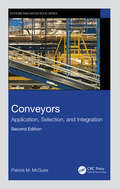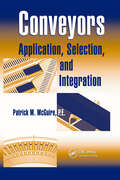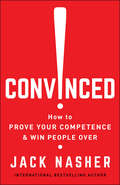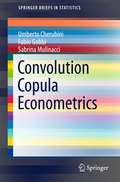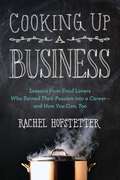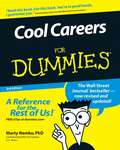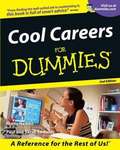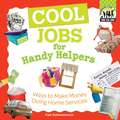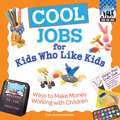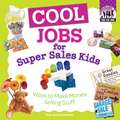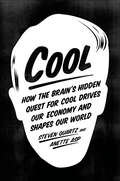- Table View
- List View
Conveyors: Application, Selection, and Integration (Systems Innovation Book Series)
by Patrick M McGuireThis new edition continues on its journey of being an introduction to the wide variety of conveyor types and application methods available. It discusses conveyor and system design and in its new edition, expands on information about sorters and motorized roller conveyors, new information on robotic interfaces, as well as some of the trade-offs made when conveyor design rules are intentionally broken. Each chapter now also includes questions and problems to help reinforce the material covered. Conveyors: Application, Selection, and Integration includes a pictorial of various installations of conveyors in detail that the reader can model after. It presents common application mistakes made and discusses how the reader can avoid them in the future during the integration process. The book focuses on conveyor application information that is offered in just this book and discusses the effect that extreme temperatures have while providing real-life examples of conveyor system design that may at times break common design rules. This book is a resource for engineers, managers, and executives who want to gain a better understanding of conveyors and their application. It is also for colleges and universities that offer industrial and/or manufacturing engineering curricula.
Conveyors: Application, Selection, and Integration (Systems Innovation Book Series)
by Patrick M McGuireThis is probably the first book in 40 years to comprehensively discuss conveyors, a topic that seems mundane until the need arises to move material from point A to point B without manual intervention. This book gives industrial designers, engineers, and operations managers key information for determining which type of conveyor to purchase and how to use it to meet their transport needs. It discusses requirements for specific products or materials and environmental factors, including extreme temperatures. Each chapter covers a specific type of conveyor including chain, belt, and gravity varieties, highlighting the primary features such as load capacity and rate and operation.
Convince Them in 90 Seconds or Less: Make Instant Connections That Pay Off in Business and in Life
by Nicholas BoothmanNow in paperback, revised throughout, with a timely new chapter and title—The original How to Connect in Business in 90 Seconds or Less received praise such as: "Nick Boothman's brilliant stroke is to guarantee that within the first 90 seconds of meeting someone you'll be communicating like old trusted friends. But he doesn’t stop there. This book shows how to turn those instant connections into long-lasting, productive business relationships."—Marty Edelston, publisher, BottomLine/Personal. And: "Success in business depends on effectively communicating ideas, at least as much as thinking them up, and Boothman tells us how to do that."—Matthew Bishop, The Economist. Boothman's message is central, and in this current business climate, critical: whether selling, interviewing, or motivating a team, success depends on convincing the other person—and the quickest and best way to do that is through what he calls "rapport by design." Using the science of Neuro-Linguistic Programming (built upon body language, attitude, voice, and synchronizing behavior), Boothman shows how to create a winning first impression and, within 90 seconds, a lasting trust. Then, when those 90 seconds are up, he shows how to master the people-to-people skills that are essential to an ongoing business relationship. A new chapter added just for the paperback serves as a communication primer—drawing on his years in advertising, Boothman reveals how to make your message stand out and stick in a world that's already glutted with information.
Convinced!: How to Prove Your Competence & Win People Over
by Jack NasherCompetence does not speak for itself! You can't simply display it; you have to draw people's attention to it. World-renowned negotiation and deception detection expert, business professor, and mentalist Jack Nasher offers effective, proven techniques to convince others that we are talented, trustworthy, and yes, even brilliant. Nasher offers the example of Joshua Bell, possibly the world's most famous violinist. In January 2007, at rush hour, he stepped into a Washington, DC, subway station, dressed like any street busker, and began to play a $4,000,000 Stradivarius. It was part of an experiment staged by a journalist of the Washington Post, who expected Bell's skill alone to attract an immense, awed crowd. But Bell was generally ignored, and when he stopped, nobody applauded. He made $34.17.The good news is that you don't have to accept obscurity: you can positively affect others' perception of your talent. Whether you're looking for work, giving an important presentation, seeking clients or customers for your business, or vying for a promotion, Nasher explains how to use techniques such as expectation management, verbal and nonverbal communication, the Halo Effect, competence framing, and the power of nonconformity to gain control of how others perceive you. Competence is the most highly valued professional trait. But it's not enough to be competent, you have to convey your competence. With Nasher's help you can showcase your expertise, receive the recognition you deserve, and achieve lasting success.
Convolution Copula Econometrics (SpringerBriefs in Statistics)
by Umberto Cherubini Sabrina Mulinacci Fabio GobbiThis book presents a novel approach to time series econometrics, which studies the behavior of nonlinear stochastic processes. This approach allows for an arbitrary dependence structure in the increments and provides a generalization with respect to the standard linear independent increments assumption of classical time series models. The book offers a solution to the problem of a general semiparametric approach, which is given by a concept called C-convolution (convolution of dependent variables), and the corresponding theory of convolution-based copulas. Intended for econometrics and statistics scholars with a special interest in time series analysis and copula functions (or other nonparametric approaches), the book is also useful for doctoral students with a basic knowledge of copula functions wanting to learn about the latest research developments in the field.
Cook Composites and Polymers Co.
by Rachel Gordon Michael W. Toffel Deishin LeeThis case describes how a company improves resource efficiency and process quality in its manufacturing process by developing a waste by-product into a new product. The case describes how CCP cleans production equipment between batches using styrene, which becomes a costly hazardous waste. Having worked on minimizing waste for the past 20 years, CCP believed it could not reduce the use of styrene without risking product quality. Instead, CCP was exploring the development of a by-product from its "rinse styrene," but faces uncertainty regarding the operational, financial, and environmental implications of doing so. This case contains data to support quantitative analyses of financial, operational, and environmental issues including some basic life-cycle analysis (LCA) calculations that focus on greenhouse gas emissions.
Cookery for the Hospitality Industry
by Graham DodgshunA must-have book for thirty years, and now in its sixth edition, Cookery for the Hospitality Industry remains Australia's most trusted and reliable reference for commercial cookery students, apprentice chefs and those studying vocational courses in schools. It covers the essential skills, methods and principles of cookery as well as the core competencies listed within the Australian National Training Package for Commercial Cookery. This book provides trade apprentices and commercial cookery students with everything they need to know to achieve trade status and more. It is the only textbook that genuinely addresses the needs of Australian students by covering Australian qualifications and reflecting Australian conditions, ingredients and our unique cuisine.
Cooking Down a Storm: Changing Culture at Pasta Serafina (A)
by Francesca Gino Raffaella Sadun Susanna GallaniPlant management at Pasta Serafina, a pasta producer in the south of Italy, is struggling to contain employee absenteeism. While the misbehavior is concentrated in a minority of the workers, its effects impact not only the plant's performance, but also the climate and work environment. Embedded in institutional and legal environment that allows very little room for corrective action, and already dealing with persistent low margins, management decides to address the issue by asking the employees themselves to find a solution to the problem. The case exposes students to managerial challenges associated with curbing moral hazard and changing the company culture in a setting where standard legal and contractual tools, such as firing workers for performance or using incentives to influence behaviors, are not available.
Cooking Down a Storm: Changing Culture at Pasta Serafina (B)
by Francesca Gino Raffaella Sadun Susanna GallaniThe case complements Pasta Serafina (A) by describing the aftermath of a town hall meeting in which management had publicly denounced the absenteeism problem and challenged the employees to find a solution. In spite of the initial mistrust against management, the fear of an imminent plant closure coupled with the relief associated with finally being able to be heard by management, pushes the employees to act to contain the problem themselves. Within a short time, absenteeism hits record lows. Management, however, is left wondering about the sustainability of the new culture.
Cooking Up a Business
by Rachel HofstetterStories and advice for creating a business out of the food you love. Do you have a passion for delicious food and want to create your own business out of it, but have no idea where to start? Cooking Up a Business is essential reading for aspiring entrepreneurs and gives you a real-world, up-close-and-personal preview of the exciting journey. Through profiles and interviews with nationally known food entrepreneurs from Popchips, Vosges Haut-Chocolat, Hint Water, Mary's Gone Crackers, Love Grown Foods, Kopali Organics, Tasty, Evol, Justin's Nut Butters, Cameron Hughes Wine, and more, you will gain applicable, practical guidance that teaches you how to succeed today: * How to create a national brand--with no connections or experience * The secret to getting meetings with grocery store buyers * The number one thing you need to know about food safety regulations * Why a grassroots budget might actually help you succeed * Specific advice for gluten-free, organic, wine, and beverage companies * What every entrepreneur wishes someone had told them at the beginning * Why doing what you love is always a good idea
Cooklin's Garment Technology for Fashion Designers
by John Mcloughlin Gerry Cooklin Steven George Hayes Dorothy FaircloughBuild the knowledge and understanding of garment technology essential to any designer In today's competitive fashion industry, it is essential that designers have a working understanding of garment technology. This 2nd edition has been comprehensively updated, with in-depth information on stitches, guides and attachments and sewing techniques, all of which are fully illustrated. There are enhanced chapters on machine and equipment technology explaining the uses, features and limitations of garment manufacturing equipment, enabling designers to create products that can be manufactured efficiently and with a high degree of quality. Approached from the fashion designer's mindset, this book features illustrations to help users build their knowledge and understanding Blends theoretical and practical material Updated with the latest and most modern advances in clothing technology Illustrated throughout to help shape the reader's knowledge and understanding of garment technology
Cool Careers For Dummies
by Marty Nemko Richard N. Bolles<p>Every year, thousands of people change careers. Whether you are arecently graduated student looking to put what you studied to good use or an experienced professional looking for a change in routine,finding a career that really suits you can be a daunting task. <p><i>Cool Careers for Dummies</i> helps you discover what you really want out of life, what your passions are, and how well you perform in different environments, and then shows you how to use this information to find a career that suits you. Now revised and up-to-date, this easy-to-use guidebook helps you explore your job options and make clear-minded decisions. This new edition gives you the tools you need to: <p> <li>Search for and find a career that fits your talents <li>Land the job you want <li>Train for your new found career <li>Mold your resume into a masterpiece <li>Put on a stunning interview <li>Improve your career by making the most out of your job <li>Explore the fun and profit of self-employment</li> <p> <p>Along with these features, <i>Cool Careers for Dummies</i> provides a self-assessment section to help you identify your interests. After answering a few questions about yourself,you’ll apply your answers to the Cool Careers Yellow Pages, which profiles more than 500 great careers. It also lets you in on some unwritten codes of the office, such as having integrity,defusing saboteurs, and maintaining office relationships. So what are you waiting for? <i>Get Cool Careers for Dummies</i> and find the job of your dreams today!
Cool Careers for Dummies (2nd edition)
by Marty Nemko Paul Edwards Sarah EdwardsIs your career path unclear? Are you stuck in a job you hate? Don't worry! Now revised and updated, this friendly guide helps you think outside the box and find a job you'll actually like. Written by a trio of renowned job- counseling experts, it's like having your very own dream team of career coaches! Marty Nemko has career coached 1,600 clients. His column appears in the classified section of the LA. Times and on Monster.com. Paul and Sarah Edwards career and self-employment books have sold over 1 million copies. Discover how to: *Locate and land terrific jobs *Get the training you need *Locate jobs, even if you hate networking *Become an employer's #1 job candidate *Make a humdrum job better.
Cool Companies: How The Best Businesses Boost Profits And Productivity By Cutting Greenhouse-Gas Emissions
by Joseph J. RommDespite ongoing negotiations, consensus has not yet been reached on what action will be taken to combat global warming. A number of companies have looked beyond the current stalemate to see the prospect of reducing greenhouse-gas emissions not as a roadblock to growth and innovation but as a unique opportunity to increase profits and productivity. These "cool" companies understand the strategic importance of reducing heat-trapping emissions and have worked to cut their emissions by fifty percent or more. In the process, they have not only reduced their energy bill, but have increased their productivity, sometimes dramatically.In Cool Companies, energy expert Joseph Romm describes the experiences of these remarkable firms, as he presents more than fifty case studies in which bottom line improvements have been achieved by improving processes, increasing energy efficiency, and adopting new technologies. Romm places efforts to reduce emissions in the context of proven corporate strategies, showing managers how they can build or retrofit their operations with the latest technologies to reduce emissions and achieve quick returns on the investment. Case studies illustrate the concept of "lean production" and why systematic efforts to reduce emissions so often lead to productivity gains; explain how changes in office and building design can significantly increase productivity; present options for "cool" power -- from cogeneration to solar, wind, and geothermal energy; and explain energy efficiency in manufacturing.In profiling successful companies such as DuPont, 3M, Compaq, Xerox, Toyota, Verifone, Perkin-Elmer, and Centerplex, among many others, Cool Companies turns on its head the notion that the effort to combat global warming will come with massive costs to the industrial sector. It is a unique and essential business book for anyone concerned with increasing profits and productivity while reducing greenhouse gas emissions.
Cool Companies: How the Best Businesses Boost Profits and Productivity by Cutting Greenhouse Gas Emmissions
by Joseph J. Romm'Cool Companies' turns on its head the idea that measures to avert global warming and climate change will pile massive costs on to the industrial sector. It shows how the smartest companies have been able to make money through the improvements that reduce their greenhouse gas emissions. Industry is going to have to adjust to the new tax and regulatory regimes being introduced around the world, aimed at reducing emissions and meeting internationally agreed targets. The more far-sighted companies have recognised the opportunities this offers. Joseph Romm shows how successful they have been in taking them. Romm profiles more than 50 companies, and describes their experiences in the context of their corporate strategies. All are leaders in their sectors and many are household names such as Xerox, Toyota, BP (now BP Amoco), DuPont, Compaq and 3M. They grasped early on the strategic importance of cutting emissions. By working to do so, through increased efficiency, new technologies and improved processes, they have cut their energy costs and boosted their productivity, often dramatically - improvements which translate straight down to the bottom line. The message is clear. Cool Companies - those prepared to overhaul their policies and innovate - are much more likely to thrive in the new climate for business, while those which have to be dragged backwards into the future will face higher costs and tougher competition.
Cool Hotels
by Jacob Termansen Kim Inglis Pia Marie MolbechCool Hotels showcases the best hotels in India, the Maldives and Sri Lanka. Be it a rustic retreat or a five-star, super-deluxe resort that can hold its own globally, all are at the cutting-edge of the new wave of hotel design and management. Each property has been hand-picked according to a set of criteria that includes a strong design aesthetic, architectural integrity, a commitment to service and a sense of individuality. A million miles away from cookie-cutter approach of chain hotels. Many of the properties have never been featured in guides before and many are just recently opened. With over 500 ravishingly beautiful full color photographs, Cool Hotels is the first in a series of hotel guides focusing on Asia. Ultimately these will be the definitive guides exclusively showcasing the best of Asia's unique places to stay.
Cool Jobs for Handy Helpers: Ways to Make Money Doing Home Services
by Pam ScheunemannKids want to make money! This fun and creative title introduces young readers to the idea of working in a format that is easy to read and use. From cleaning the house to gift wrapping, this book contains kid-tested projects that will have children earning money--and loving it! Instructions and photographs guide kids through the process of business plans, safety, marketing, gathering customer information, and providing a product or service. Background information, materials lists, and additional ideas provide a fun and organized approach to the world of work! Checkerboard is an imprint of ABDO Publishing Company.
Cool Jobs for Kids Who Like Kids: Ways to Make Money Working with Children
by Pam ScheunemannKids want to make money! This fun and creative title introduces young readers to the idea of working in a format that is easy to read and use. From play groups to crafts, this book contains kid-tested projects that will have children earning money--and loving it! Instructions and photographs guide kids through the process of business plans, safety, marketing, gathering customer information, and providing a product or service. Background information, materials lists, and additional ideas provide a fun and organized approach to the world of work! Checkerboard is an imprint of ABDO Publishing Company.
Cool Jobs for Super Sales Kids: Ways to Make Money Selling Stuff
by Pam ScheunemannKids want to make money! This fun and creative title introduces young readers to the idea of working in a format that is easy to read and use. From garage sales to bake sales, this book contains kid-tested projects that will have children earning money--and loving it! Instructions and photographs guide kids through the process of business plans, safety, marketing, gathering customer information, and providing a product or service. Background information, materials lists, and additional ideas provide a fun and organized approach to the world of work! Checkerboard is an imprint of ABDO Publishing Company.
Cool Jobs for Yard-Working Kids: Ways to Make Money Doing Yard Work
by Pam ScheunemannKids want to make money! This fun and creative title introduces young readers to the idea of working in a format that is easy to read and use. From weeds to snow, this book contains kid-tested projects that will have children earning money--and loving it! Instructions and photographs guide kids through the process of business plans, safety, marketing, gathering customer information, and providing a product or service. Background information, materials lists, and additional ideas provide a fun and organized approach to the world of work! Checkerboard is an imprint of ABDO Publishing Company.
Cool Jobs for Young Entertainers: Ways to Make Money Putting on an Event
by Pam ScheunemannKids want to make money! This fun and creative title introduces young readers to the idea of working in a format that is easy to read and use. From carnivals to haunted houses, this book contains kid-tested projects that will have children earning money--and loving it! Instructions and photographs guide kids through the process of business plans, safety, marketing, gathering customer information, and providing a product or service. Background information, materials lists, and additional ideas provide a fun and organized approach to the world of work! Checkerboard is an imprint of ABDO Publishing Company.
Cool Jobs for Young Pet Lovers: Ways to Make Money Caring for Pets
by Pam ScheunemannKids want to make money! This fun and creative title introduces young readers to the idea of working in a format that is easy to read and use. From dog walking to pet accessories, this book contains kid-tested projects that will have children earning money--and loving it! Instructions and photographs guide kids through the process of business plans, safety, marketing, gathering customer information, and providing a product or service. Background information, materials lists, and additional ideas provide a fun and organized approach to the world of work! Checkerboard is an imprint of ABDO Publishing Company.
Cool Jobs in Basketball
by Peter GutierrezChildren's book that describes three people who got jobs in the NBA, but not as players.
Cool War
by Noah FeldmanA bold and thought-provoking look at the future of U.S.-China relations, and how their coming power struggle will reshape the competitive playing field for nations around the world The Cold War seemingly ended in a decisive victory for the West. But now, Noah Feldman argues, we are entering an era of renewed global struggle: the era of Cool War. Just as the Cold War matched the planet's reigning superpowers in a contest for geopolitical supremacy, so this new age will pit the United States against a rising China in a contest for dominance, alliances, and resources. Already visible in Asia, the conflict will extend to the Middle East (U.S.-backed Israel versus Chinese-backed Iran), Africa, and beyond. Yet this Cool War differs fundamentally from the zero-sum showdowns of the past: The world's major power and its leading challenger are economically interdependent to an unprecedented degree. Exports to the U.S. account for nearly a quarter of Chinese trade, while the Chinese government holds 8 percent of America's outstanding debt. This positive-sum interdependence has profound implications for nations, corporations, and international institutions. It makes what looked to be a classic contest between two great powers into something much more complex, contradictory, and badly in need of the shrewd and carefully reasoned analysis that Feldman provides. To understand the looming competition with China, we must understand the incentives that drive Chinese policy. Feldman offers an arresting take on that country's secretive hierarchy, proposing that the hereditary "princelings" who reap the benefits of the complicated Chinese political system are actually in partnership with the meritocrats who keep the system full of fresh talent and the reformers who are trying to root out corruption and foster government accountability. He provides a clear-eyed analysis of the years ahead, showing how China's rise presents opportunities as well as risks. Robust competition could make the U.S. leaner, smarter, and more pragmatic, and could drive China to greater respect for human rights. Alternatively, disputes over trade, territory, or human rights could jeopardize the global economic equilibrium--or provoke a catastrophic "hot war" that neither country wants. The U.S. and China may be divided by political culture and belief, but they are also bound together by mutual self-interest. Cool War makes the case for competitive cooperation as the only way forward that can preserve the peace and make winners out of both sides.Advance praise for Cool War "We are leaving the era of 'Chimerica'--when China and America were economically joined at the hip--and entering the era of what Noah Feldman has justly and wittily dubbed 'Cool War.' Feldman anatomizes the rapid transformation of the Sino-American relationship from an unequal trading partnership into a new and heavily armed ambivalence. Just how cool the conflict stays, Feldman suggests, will be determined not in cyberspace or at sea but in international institutions. Cool War is essential reading for any serious student of the emergent bipolar order in the Asia-Pacific region."--Niall Ferguson, New York Times bestselling author of Colossus: The Rise and Fall of the American Empire and Civilization: The West and the Rest "By giving realism and liberal internationalism their due, and by giving credence to both naked self-interest and legal norms, Noah Feldman's dissection of the United States-China relationship is smart, balanced, and wise."--Robert D. Kaplan, New York Times bestselling author of The Revenge of Geography
Cool: How the Brain's Hidden Quest for Cool Drives Our Economy and Shapes Our World
by Steven Quartz Anette Asp“This engrossing history merges evolutionary biology and economics to explain our spending habits” and show how coolness is at the heart of consumerism (Mental Floss).We live in a world of conspicuous consumption, where the things we buy not only satisfy our needs, but also communicate our values, identities, and aspirations. In Cool, Steven Quartz and Anette Asp bring together groundbreaking findings in neuroscience, economics, and evolutionary biology to show how our concepts of “cool”—be it designer jeans, smartphones, or craft beer—help drive the global economy.Cool puts forth a provocative theory of consumerism based on our brain’s innate status-seeking and “social calculator”. The authors highlight the underlying processes that guide our often-unconscious decision making. They also pull back the curtain on “choice architects” who design store interiors, as well as “coolhunters” who scour Berlin and Tokyo for the latest trends.Quartz and Asp follow the evolution of “cool consumption” from the mid-twentieth century through the emergence of the Internet in the 1990s, finally unpacking the social motivations behind today’s hip, ethical consumption. Taking us from Norman Mailer to normcore, Cool is surprising at every turn, and will forever change the way you think about money, status, and your next purchase.
